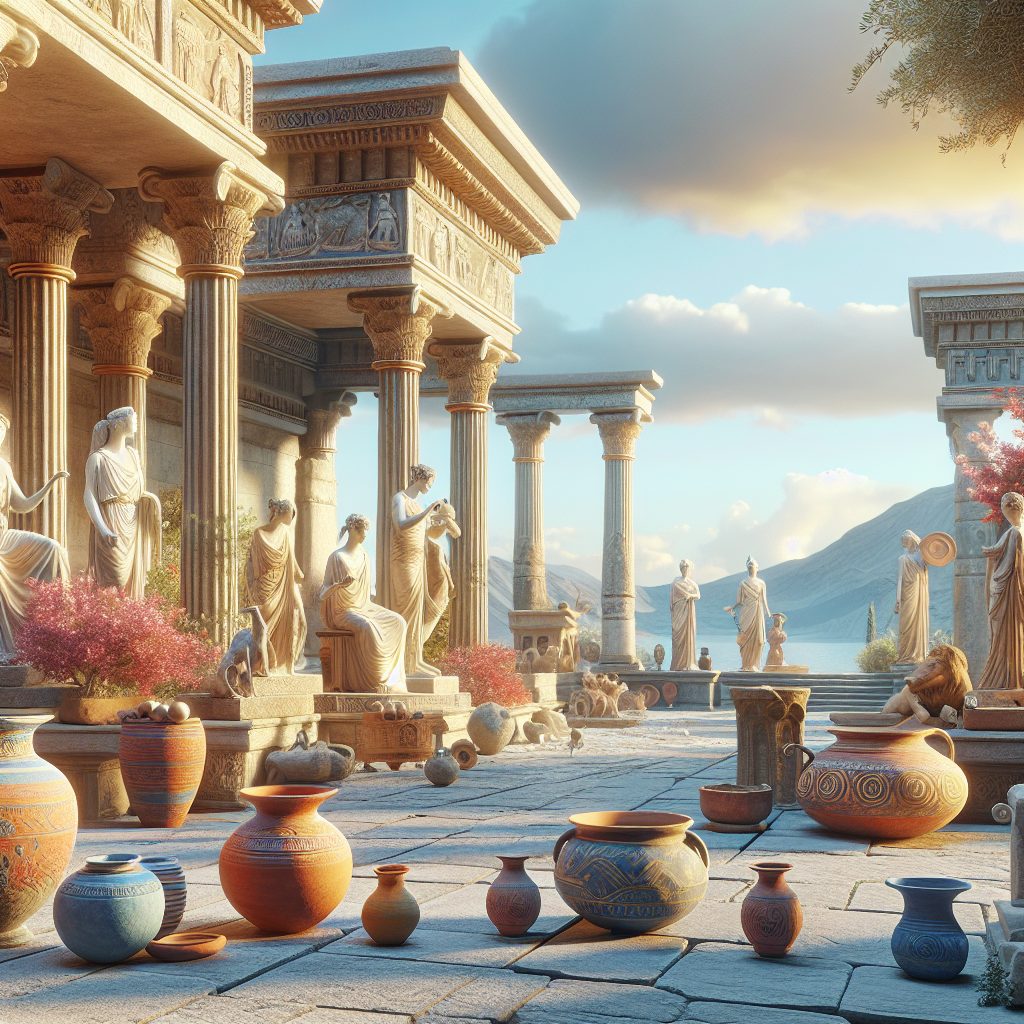Tharros ancient civilization, also known as Tharros, is a fascinating archaeological site located on the western coast of Sardinia, Italy. This ancient city was founded by the Phoenicians in the 8th century BC and thrived as an important trading hub throughout its existence. One unique fact about Tharros is its strategic position, overlooking the Mediterranean Sea, which made it a significant port city during ancient times. This advantageous location allowed the civilization to flourish, as it became a key player in the maritime trade network of the Mediterranean.
Impressively, Tharros boasts several impactful features that make it a must-visit destination for history enthusiasts. One of its distinct characteristics is the remnants of its ancient city walls, which provide a glimpse into the city’s fortified nature. Additionally, the ruins of numerous buildings, temples, and even a Roman theater can be explored, offering a window into the daily life and architectural marvels of the Tharros civilization.
In the upcoming sections, we will delve deeper into the key takeaways from Tharros, shedding light on its economic significance, cultural influences, and historical context. By uncovering these insights, readers will gain a comprehensive understanding of this ancient civilization and its lasting impact on Sardinian history. So, let us embark on a journey through time and explore the remarkable world of Tharros.
Key Takeaways
1. Tharros was an ancient city located on the western coast of Sardinia, Italy, and was a significant center of trade and commerce in the Mediterranean region during the 8th to 5th centuries BCE.
2. The civilization of Tharros flourished primarily due to its strategic coastal location, which facilitated maritime trade and attracted various merchants from different parts of the Mediterranean.
3. Archaeological excavations in Tharros have revealed the remains of structures such as houses, temples, and fortifications, providing insights into the city’s layout and architecture.
4. The city’s economic prosperity can be attributed to its production and exportation of valuable commodities like pottery, metals, and salt, as well as its involvement in the thriving trade networks of the Mediterranean.
5. Tharros also played a role in the religious and cultural spheres, boasting numerous sanctuaries and a diverse range of artistic artifacts that reflect the influence of different civilizations, such as the Phoenicians and Romans, on the city’s development.
What is the significance of Tharros ancient civilization?
The Location and History of Tharros
Tharros was an ancient civilization located in the western part of Sardinia, Italy. It was founded by the Phoenicians around the 8th century BC and later came under Carthaginian, Roman, and Byzantine rule.
Archaeological Discoveries
Tharros is renowned for its rich archaeological heritage. Excavations have unearthed various ruins and artifacts, shedding light on the ancient civilization’s way of life. Notable discoveries include a Roman temple, a necropolis, and various residential structures.
Social Structure and Economy
Tharros was a thriving city with a well-organized social structure. It is believed that the society was divided into different classes, including the ruling elite, merchants, farmers, and slaves. The economy revolved around agriculture, trade, and fishing, with evidence of extensive maritime activities.
Religious Beliefs and Rituals
The ancient Tharros civilization had a complex religious system. The Phoenician influence is evident in the worship of deities such as Melqart and Astarte. Rituals and ceremonies were performed in sacred temples, with offerings made to appease the gods and seek their favor.
Art and Architecture
The Tharros civilization showcased impressive artistic and architectural skills. The ruins of the Roman temple exhibit intricate carvings and detailed designs. Additionally, mosaics and statues have been discovered, revealing the level of craftsmanship prevalent during that era.
Trade and Cultural Exchange
Tharros served as an important trading hub due to its strategic location. The civilization engaged in trade with various Mediterranean cultures, such as the Phoenicians, Greeks, and Romans. This interaction led to a significant exchange of ideas, technologies, and cultural practices.
Decline and Abandonment
Tharros experienced a gradual decline, primarily due to political instability and changes in power. The city faced attacks from various invaders over the centuries, including the Vandals and Saracens. Eventually, Tharros was completely abandoned, and its ruins stood as a testament to its former glory.
Guides for Exploring Tharros Today
- Visit the archaeological site: Take a trip to Tharros to experience the remnants of this ancient civilization firsthand. Explore the ruins and gain insights into the daily life of its inhabitants.
- Learn from the museum exhibits: The nearby museum houses a collection of artifacts and displays that provide deeper insights into the Tharros civilization. Take the time to immerse yourself in the history and culture of the ancient city.
- Participate in guided tours: Join a guided tour to have a more comprehensive understanding of Tharros. Expert guides can offer detailed explanations and answer any questions you may have.
- Enjoy the natural surroundings: Tharros is located in a picturesque coastal area. Take a moment to appreciate the stunning views and enjoy the nearby beaches, making your visit to Tharros a memorable experience.
Frequently Asked Questions
1. What is Tharros ancient civilization?
Tharros ancient civilization refers to the historical society that thrived in the ancient city of Tharros, located in present-day Sardinia, Italy. It was a vibrant civilization known for its strategic position as a port, rich cultural heritage, and architectural marvels.
2. How old is Tharros ancient civilization?
Tharros ancient civilization dates back to around the 8th century BC, making it over 2,800 years old. It flourished until the Roman era and gradually declined after the fall of the Roman Empire.
3. What were the major accomplishments of Tharros ancient civilization?
Tharros ancient civilization boasted impressive achievements in various fields. Its skilled craftsmen produced intricate pottery and artworks. The city was renowned for its advanced urban planning, featuring well-organized streets, public buildings, and houses. Tharros was also a crucial center for trade and maritime commerce.
4. What led to the decline of Tharros ancient civilization?
The decline of Tharros ancient civilization can be attributed to multiple factors. It faced invasions from several external forces, such as Vandals and Saracens. Additionally, changes in trade routes and the rise of other port cities contributed to its downfall. Natural disasters, including earthquakes and rising sea levels, also played a role in the abandonment and subsequent decline of Tharros.
5. Can the remains of Tharros ancient civilization be visited today?
Yes, the remains of Tharros ancient civilization can still be visited today as an archaeological site. Located on the picturesque Sinis Peninsula, visitors can explore the well-preserved ruins, including the ancient city walls, temples, houses, and even a Roman amphitheater. It offers a fascinating glimpse into the rich history of the region.
6. Are there any museums dedicated to Tharros ancient civilization?
While there isn’t a specific museum dedicated solely to Tharros ancient civilization, artifacts and findings from the site can be seen in various museums in Sardinia. The National Archaeological Museum of Cagliari, for example, hosts a collection that includes objects from Tharros, shedding light on its culture and history.
7. Did Tharros ancient civilization have any cultural or religious significance?
Yes, Tharros ancient civilization had significant cultural and religious importance. It was a center of religious worship, featuring temples dedicated to deities such as Tharros (thought to be a local deity), Juno, and Neptune. The ancient city also provided a fertile ground for cultural exchange, influencing neighboring regions through its trade and artistic endeavors.
8. How was the governance system of Tharros ancient civilization?
Tharros ancient civilization had a well-structured governance system. It was initially influenced by Phoenician and Carthaginian civilizations and later fell under the rule of the Roman Empire. The city was governed by local authorities, and its political and social structures evolved over time.
9. What is the significance of Tharros ancient civilization in history?
Tharros ancient civilization holds immense historical significance as an important hub for trade and cultural exchange. It played a crucial role in the development of the Mediterranean region, contributing to the spread of ideas, technologies, and artistic influences. The ruins of Tharros offer valuable insights into ancient seafaring civilizations and their impact on the wider world.
10. How can we learn more about Tharros ancient civilization?
To learn more about Tharros ancient civilization, one can explore various scholarly publications, archaeological studies, and historical resources dedicated to the topic. Visiting the archaeological site of Tharros and museums in Sardinia that display artifacts from the civilization can provide firsthand experiences and knowledge.
Final Thoughts
The ancient civilization of Tharros stands as a captivating testament to the ingenuity and resilience of past societies. Its strategic location, cultural richness, and architectural wonders make it a subject of intrigue and fascination for history enthusiasts worldwide. Exploring the ruins of Tharros and delving into its history offers a unique opportunity to connect with the past, gaining valuable insights into the roots of civilization and the profound impact of maritime trade on ancient cultures.
As the remnants of Tharros continue to inspire awe and curiosity, it is important to preserve and protect these invaluable historical sites. By understanding and appreciating ancient civilizations like Tharros, we not only enrich our existing knowledge but also ensure that the legacies of the past are safeguarded for generations to come.






